
Poland Covered Bridge Stabilization: 2001
[WGN 45-08-02]

Poland Bridge Stabilization Index
- Phase 1
- Phase 2
The Poland Covered Bridge Stabilization Update: February 2001
Work Begins on Cambridge Junction Covered Bridge
Kick-off Meeting Held
Cambridge, Vt. February 12 - The Cambridge Junction Covered Bridge stabilization project kick-off meeting was held at 10:00 a.m., a cold Monday with the temperature in the teens.
Gathered before the portal of the old bridge were: Ron Bechard, Vermont Covered Bridge Society Bridge-watch; Al Campo, Agency of Transportation NW Regional Construction Engineer; Ray Hayes, AOT Project Resident Engineer; David Hoyne, AOT Structures Project Manager; Frank Hutchins, Town of Cambridge Selectman; Bill McKone, VCBS V.P. & Bridge-watch Chair.; Joe Nelson, VCBS Pres. & newsletter editor; Pam Thurber, AOT Bridge Inspection Program, Dana Sweet, Town of Cambridge Selectboard Chair.; and John Weaver, AOT Materials Engineer.
The work on the bridge will be done in two stages under separate contracts, said Hoyne. The first stage will stabilize and raise the bridge to protect it from high water, ice and flotsam. The second stage will restore the bridge to carry light traffic.
The first stage is to be complete by March 30, the plans and specifications for the second stage must be completed by September 1, Hoyne said. "We're going to advertise [for contractors] at that point and we'll probably have a completion date of the following fall. We have to have the plans completed by September, that's the critical milestone to keep all of the money."
The funds for the work on the bridge are coming from the $10 million National Historic Bridge Program announced by Senator James Jeffords last August. The $1 million provided for the Cambridge Junction Bridge was received by the Vermont Agency of Transportation in August to be immediately available to allow steps to be taken to ensure that the bridge survives the winter. An estimated $200,000 will be spent on the first phase of the project; to stabilize the structure against heavy snow load or additional ice damage.
"So the plan of attack at this point," said Hoyne, "The contractor is going to come in and remove the runners [from the bridge floor, lightening dead load], install vertical [steel] rod [by each vertical post], they are going to excavate behind the ends of the bridge so they can get their jacks in there and they going to [raise the bridge] a little bit at a time."
The bridge is to be raised and set on timber cribbing to a height of about three feet.
The bridge is located a few yards from a right-of-way that once belonged to the St. Johnsbury and Lamoille County Railroad. "There is a push on to get this railroad put back in service," said Sweet. "I think whatever you do, I don't think we can infringe on that without taking on the commitment to raise the grade of the tracks, I don't think we want to get messed up in that right now."
"We are going to do everything we can to avoid that," replied Hoyne. We've got to see what that leaves us for approaches. Because if you raise the grade three feet, it might not be an ideal situation, but as long as its for light vehicles, most light vehicles can negotiate an eight or ten percent grade without much difficulty. The bridge is to be designed for light vehicle use, and we're going on the assumption of about three tons. We're doing a hydraulic study to find out how high the bridge has to be."
A preliminary study found that the bottom chords (main beams) could be 18 inches under water during the spring run-off, said Weaver.
Ultimately the bridge abutments will be worked on. "One of the abutments is sloughing off laid-up stone, falling into the river," said Hoyne. "We're going to clean up the substructure. Right now you have laid up stone, and a hodge-podge of cast concrete. For the long term project we're going to try to rebuild all of that, make it look like it was intended to." Also, in the long term, the bridge will get new roofing and siding, and a new floor system, he said.
Concerned about the angle of the roads approaching the bridge, Sweet asked how the funds have to be used.
"Normally they don't get too involved in town and highway projects," responded Hoyne. but because it's a million dollars in funds right from Jeffords' office, the Feds have elected to have full oversight, which means everything we do, they're looking very closely at. Anything other than what they deem necessary approach work to get up to the new elevation of the bridge, they are going to scrutinize very carefully. The substructure work, and reasonable approach work is all part of the project."
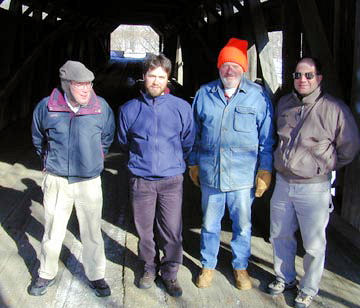
Photo by Joe Nelson
Feb. 12, 2001
From right to left: John Weaver, David Hoyne, Ray Hayes, and Al Campo
Stabilization Work Underway on Cambridge Junction Covered Bridge
Cambridge, Vt. Thursday, February 22 - A lot has happened to the Cambridge Junction Bridge since the kick-off meeting on February 12. Today there are three massive A- frames standing inside of the structure; one at each portal and one at the center of the span. In addition, two shattered diagonals (kingpost braces) have been replaced.
Anthony Daniels of Neil H. Daniels Construction, of Ascutney, Vt., winner of the stabilization contract for the bridge, also known as the Poland Bridge, describes what work is to be done:
"The stabilization contract of the Poland Bridge involves stabilizing the structure both laterally and longitudinally. We're installing bracing in the north and south portals and in the center. The bracing consists of A-frames with a horizontal top piece made rigid with bolted steel plates."
The bracing, constructed of twelve-by-twelve hemlock timbers cut from the Daniels wood lot, will keep the bridge trusses straight and parallel and prevent "racking," or leaning. "It was already leaning about four and a half inches on the south end," Tony notes.
"And secondly, we took up the oak three-by-three running plank from the bridge floor. That took about eight thousand pounds of weight off the bridge. We're trying to take as much weight off as we can because of the condition of the bottom chords.
"The third thing we are going to do is put supplemental supports on the upper chords, both inside and outside. They are going to be three-by-tens, twenty foot long, and they'll be lag-bolted every ten inches with 3/4" x 7" lag- bolts and steel washers.
"The fourth thing we're going to do is put channel irons and one-inch rods connected together as a link. The rods will be tightened with 1300 pounds of torque, and that will stabilize the bottom chords. Those channels and rods are going top and bottom of the inside and the outside chord, so there will be four runs of those rods.
"At that point, we're going to have the north abutment and south abutment excavated to about four feet below road-grade level and remove all of the debris, and get down onto stone and concrete, or whatever we find is stable.
"From there we start a cribbing process. The objective is to raise the bridge three feet to get it above ice-flow stage. And to accomplish that we're going to use electrically operated hydraulic jacks. We're going to start with very thin, what we call "pancake jacks" under each side of one of the abutments, and we're going to jack the bridge up enough to get a substantial piece of oak under it. Then we'll reposition the jacks to get about six inches. We'll go to the other end [of the bridge] and do the same process. We're going to go up in six-inch increments from north end to south end, back and forth installing blocking as we go so the bridge remains always stable, until we get our three-foot increase in elevation.
"This is all designed by John Weaver Of the Vermont Agency of Transportation. That will pretty much conclude our contract, except for the approach ramp which will be ADA acceptable and accessible to wheelchairs, and then the bridge will be turned back over to pedestrian traffic.
"The second phase will involve the complete rebuilding of the bridge. This is an interesting project, it's about an eight-week project and we hope to complete our phase before the ice goes out. We just need a lot of good luck, a lot of good days to work. If the weather stays cold we won't have work under the dripping of the eaves, so much of the work is working off of "Spider" stages that are suspended from the top chord while we put the supplemental chord re-enforcing on. If it stays cold we can [also] work from the ice and get the job done."
Part of the stabilization work required that two broken truss members be replaced. Said Mr. Daniels: "We replaced two diagonals, one on the west side, downstream, one on the east side upstream. Those are six-by-tens about twelve and a half foot long. I believe back in the middle nineties somebody hit the bridge halfway through, right near the kingposts at the center and the bridge did receive extensive damage with the interruption of the load [distribution] on those members. That was one of the first things that we did. Took about one day to jack the bridge on the ice, we spread some drillage on the ice, set a hydraulic jack on a post. We got enough relief to get the old [diagonals] out and a little more to get the new ones in, so they are under [compression] now. The bridge still has negative camber, about a foot-and-a half." The ice was eighteen inches thick, he said.
Also hard at work was foreman Alan Davis, assembling the complicated "Spider" staging that will be used when the steel channels and rods are installed on the outside of the bridge trusses.
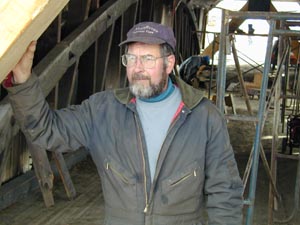
Photo by Joe Nelson
Feb. 22, 2001
Anthony Daniels
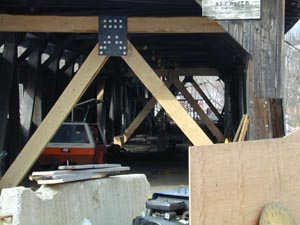
Photo by Joe Nelson
Feb. 22, 2001
The A-frame stabilizers
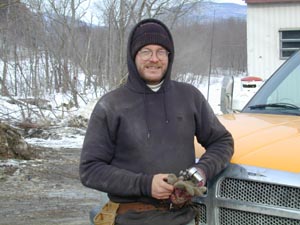
Photo by Joe Nelson
Feb. 22, 2001
Alan Davis
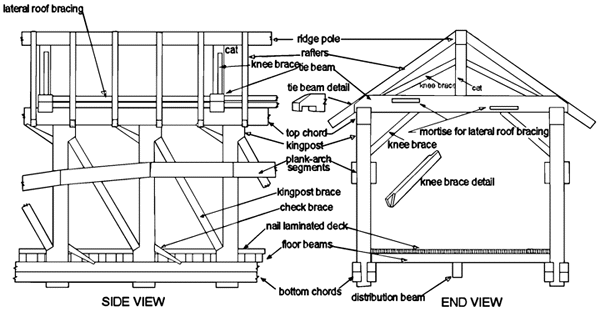
Drawing by Joe Nelson
Cambridge, Vt. Thursday, February 27 - With the three A-frames in place, the stabilization work has moved to the upstream upper chords.
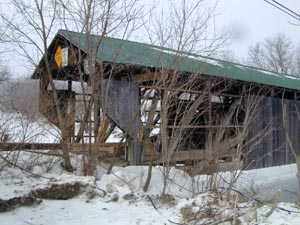
Photo by Joe Nelson
Feb. 27, 2001
Some of the upstream siding has been removed to gain access to the upper chords.
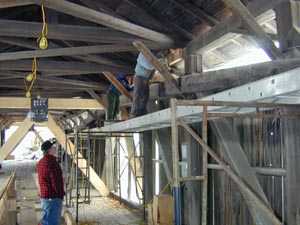
Photo by Joe Nelson
Feb. 27, 2001
The upper chords being prepared for the installation of the longitudinal bracing and the hanging of the "Spider" staging
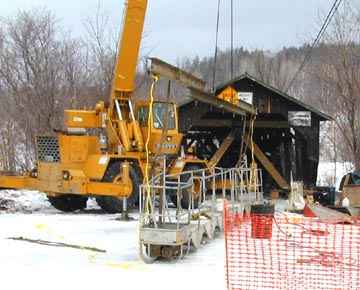
Photo by Joe Nelson
Feb. 27, 2001
The "Spider" staging is assembled and ready for hanging from the upstream upper chord.
The Poland Covered Bridge Update: March 2001
Cambridge, Vt. Monday, March 12
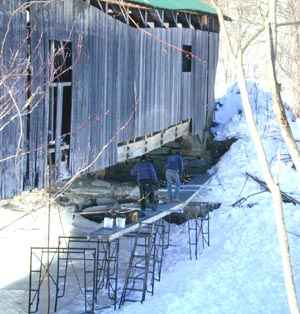
Photo by Joe Nelson
March 12, 2001
A portion of the bottom chord on the upstream side was found to have been damaged by ice some time in the past. The damaged area can be seen where the siding is cut away. All four chords, top and bottom of both trusses, are in the process of being braced in preparation for the lifting of the bridge.
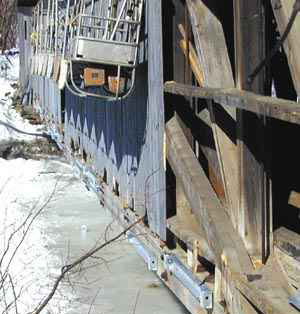
Photo by Joe Nelson
March 12, 2001
"The fourth thing we're going to do is put channel irons and one-inch rods connected together as a link. The rods will be tightened with 1300 pounds of torque, and that will stabilize the bottom chords," said Anthony Daniels. The irons and rods can be seen here on the outside of the downstream bottom chord.
The spider staging is in position for work on the upper chord.
Cambridge, Vt. Wednesday, March 14
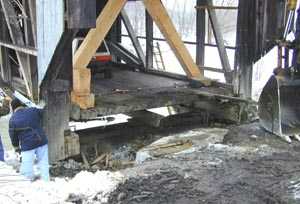
Photo by Joe Nelson
March 14, 2001
The north abutment and south abutments have been excavated to about four feet below road-grade level and the bedding for the chords has been exposed.
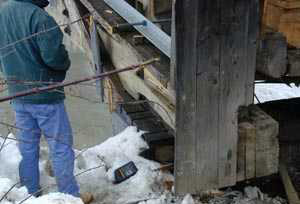
Photo by Joe Nelson
March 14, 2001
A view of the south-west corner of the bridge and exposed chord-end. It sits on a pad of hard-wood blocks atop the abutment bedding area.
Cambridge, Vt. Friday, March 16
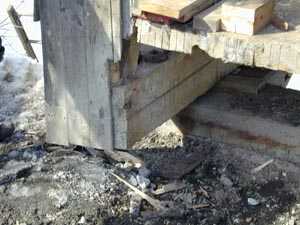
Photo by Joe Nelson
March 16, 2001
Another view of the south-west corner of the bridge and exposed chord-end. The space for a pancake jack has been cleared. When the end-panel bracing is completed, the bridge will be ready for lifting.
Cambridge, Vt. Monday, March 19
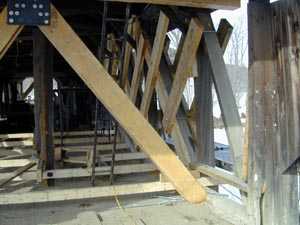
Photo by Joe Nelson
March 19, 2001
The end-panels that extend past the Burr Arch at all four corners of the bridge need to be reenforced to enable them to support the weight of the bridge during the jacking operation. The reenforcing members under construction can be seen here in the south-east-end panels of the truss.
The joists running parallel to the bridge-floor will support exterior staging.
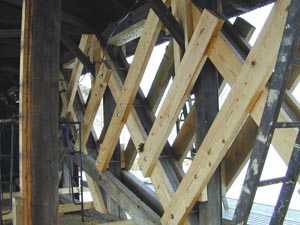
Photo by Joe Nelson
March 19, 2001
A detail view of the end-panel reenforcement structure. The timbers that slant downward toward the foreground sandwiching the kingpost braces will act as compression members. The reenforcement timbers slanting in the opposite direction will act as tension members.
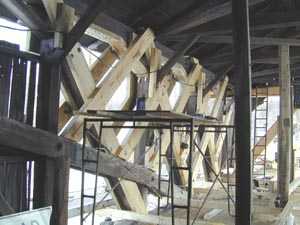
Photo by Joe Nelson
March 19, 2001
Another view of the end-panel reenforcement construction. This work needs to be done at all four corners of the bridge before the jacking operation can begin.
Cambridge Junction, Monday, March 26 - "All of the additional bracing, the lattice bracing, will be done Tuesday, the 27th," said Raymond Hayes, Resident Engineer from the VTrans Construction Division. We're starting to jack on the south end to bring it up two inches.
"Wednesday we'll bring it up four inches and we'll go back and forth, two and four, because at no time can we go up more than two inches from one end to the other," Hayes said."The plan is to have it up and on blocks, two feet by Friday, and hopefully before this ice comes."
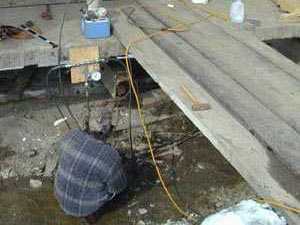
Photo by Joe Nelson
March 26, 2001
Watching the hydraulic controls and pressure gage for the "pancake" jack.
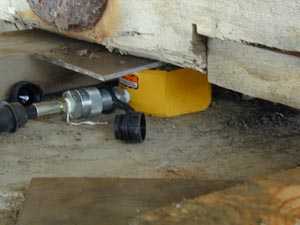
Photo by Joe Nelson
March 26, 2001
The "pancake" jack is seen here placed on the abutment under the chord-end at the south-east corner of the bridge. The jack will raise the bridge no more than two inches at a time, rotating from corner to corner.
Cambridge Junction, Wednesday, March 28 - The south end of the Poland Bridge has been raised two inches. Preparations are underway to lift the north end four inches. It is expected that the bridge will have been raised two feet by the weeks end.
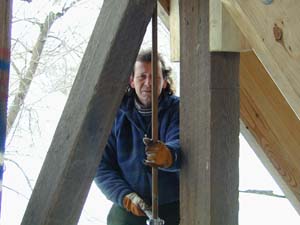
Photo by Joe Nelson
March 28, 2001
"Butch" Simoneau is installing a tension rod in the end panel at the northeast corner of the bridge.
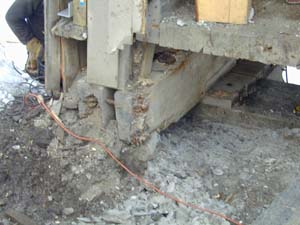
Photo by Joe Nelson
March 28, 2001
The chord-end at the northeast corner of the bridge is exposed and being made ready to receive the "pancake" jack.
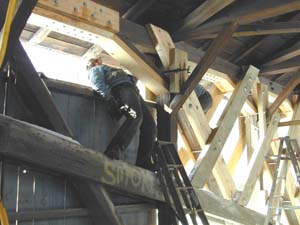
Photo by Joe Nelson
March 28, 2001
Left to right - Phil Daniels and Brian Dube are installing the reenforcing timbers at the northwest corner end panels.
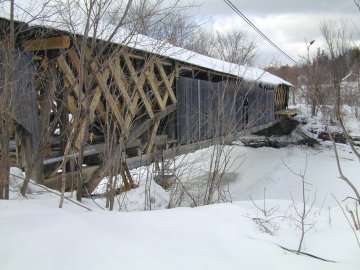
Photo by Joe Nelson
March 28, 2001
View of the Poland Bridge from the southeast end. Notice the scaffolding had been moved to facilitate the construction of the reenforcing timbers at the north end of the bridge.
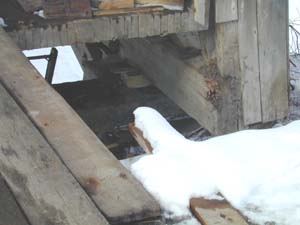
Photo by Joe Nelson
March 28, 2001
The southeast chord-end sits on a two-inch stack of shims, the "pancake" jack rotated to another corner. When the bridge has been lifted high enough, the bridge-wrights will begin to insert cribbing timbers.
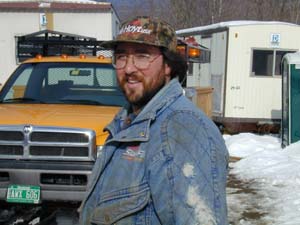
Photo by Joe Nelson
March 28, 2001
"It's up two inches, a half-inch at a time," says Brian Dube. The "pancake" jack has only a half-inch "throw," meaning that while the jack can lift a corner of this 140-foot bridge, its lifting distance is one-half inch. Then shims are inserted between the chord and the abutment and the jack is reseated to lift another half inch. The goal is an elevation of two feet.
Cambridge Junction, Saturday, March 31 - It's Saturday morning and Ray Hayes, Alan Davis, and Brian Dube are on the job under a bright morning sun. Melt water is dripping off the covered bridge roof-edge feeding a shallow pool on the ice below. The work is to continue raising the bridge on its abutments toward the goal of four feet.
Said Resident Engineer Ray Hayes; "This morning when we started they had it up twelve inches on the south end and thirteen inches on the north end. They've got it up four inches today on the south end and we just finished four inches on the north end. Next we'll go back south for another four there.
We'll get to twenty-five inches then we'll put in the permanent block and jack it up another foot." (The permanent block referred to is a cribbing of six-by-six timbers that will span and support both bottom chords at each end.)
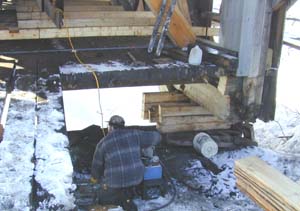
Photo by Joe Nelson
March 31, 2001
Brian Dube is operating the hydraulic controls after Alan Davis set the pancake jack under the northwest corner of the bridge.
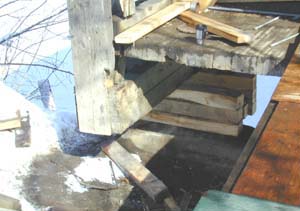
Photo by Joe Nelson
March 31, 2001
The northeast chord-end is resting on two stacks of six-by-six timber.
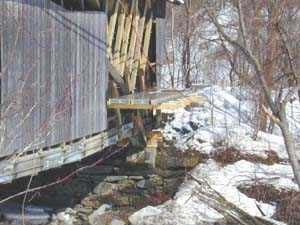
Photo by Joe Nelson
March 31, 2001
The northeast corner of the bridge viewed from the south bank of the river. The stack of six-by-six timber placed on the abutment can be seen from here. Notice the reinforcing timbers in the end panels of the truss.
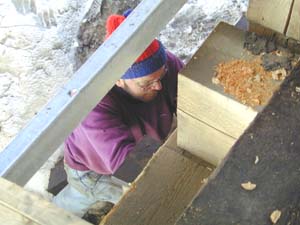
Photo by Joe Nelson
March 31, 2001
Alan Davis is setting the pancake jack and placing steel-plate shims under the northeast corner.
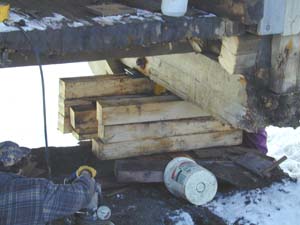
Photo by Joe Nelson
March 31, 2001
Inside view of what is happening in the photo above. Notice the steel shims on top of the inside stack of timbers. The bridge is rising on the jack leaving a space on the front stack that will be filled with a two-by-six timber shim.
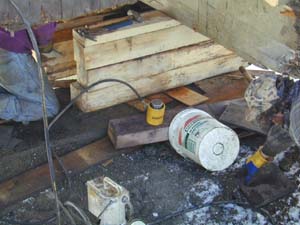
Photo by Joe Nelson
March 31, 2001
The yellow cylinder on the hydraulic tubing in the center of the photo is the 4-3/4-inch pancake jack that just lifted the corner of the bridge.
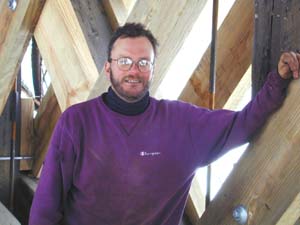
Photo by Joe Nelson
March 31, 2001
When the space under chords became high enough the 2-1/2" pancake jack was set aside and the 4-3/4" jack was used, explained Alan Davis. This jack has a 2-1/2" throw, moving the job along more quickly. They will soon be using a 14" jack which can lift up to a distance of eight inches. According to VTrans, the estimated weight of the bridge is 179,000 pounds, he said. That is approximately 89.5 Tons. These jacks, inserted under one corner of the bridge at a time, are lifting about 22 Tons.
The Poland Covered Bridge Update: April 2001
Cambridge, Vt. Monday, April 2 - The south end of the bridge has been raised 26 inches off the top of the abutment on temporary timbers. The construction crew is preparing to build the "permanent" cribbing that will support the bridge during the second phase of the planned preservation. The cribbing will be constructed of 12" x !4" timbers. When this is complete the bridge will be raised to a final height of 3 feet, two inches, Alan Davis said.
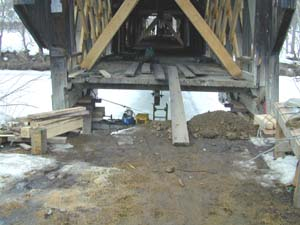
Photo by Joe Nelson
April 2, 2001
The south end of the bridge is excavated and prepared for the construction of the "permanent " cribbing.
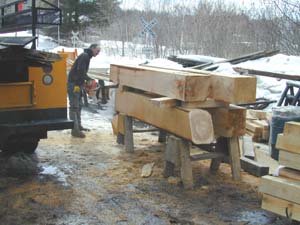
Photo by Joe Nelson
April 2, 2001
Phil Daniels prepares the 12" x !4" cribbing timbers.
Cambridge, Vt. Thursday, April 5 - Braced, reinforced, and standing three feet higher over the Lamoille River, the race to stabilize George Washington Holmes' covered bridge before this spring's high water has been won. The Stabilization phase of the work is nearly complete. Left to do is the construction of the ramps at each end and the installation of temporary siding to protect the trusses until the renovation phase begins.
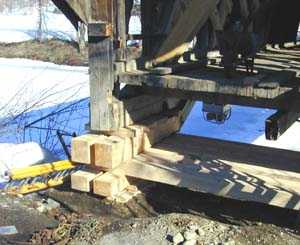
Photo by Joe Nelson
April 5, 2001
The Poland Bridge at Cambridge Junction stands on its new cribbing three feet higher over the Lamoille River than it did February 12 when the Stabilization work began.
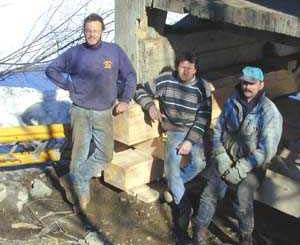
Photo by Joe Nelson
April 5, 2001
Alan Davis, Butch Simoneau, and Phil Daniels have reason to smile: they and the others on the Neal Daniels Construction team won the race to raise the bridge the three feet believed necessary to lift the bridge above this spring's high water and ice floes.
Cambridge, Vt. Cambridge, Vt. Friday, April 13 - The Daniels Construction team is finishing up the last items in the contract for the first phase of the Poland Bridge preservation project; the entry ramps and temporary siding to protect the truss from the weather during the interval between contracts.
This week they are building the ramps that will serve pedestrians and cyclists until the second phase of the project is begun, that of restoring the structure of the bridge.
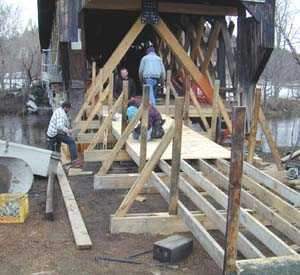
Photo by Joe Nelson
April 13, 2001
By mid-day Wednesday much of the south-end ramp was assembled in-place. The framing had been fabricated off-site and brought to the bridge by truck.
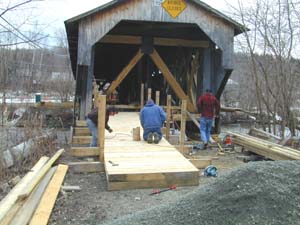
Photo by Joe Nelson
April 13, 2001
Friday the 13th and the ramp accessing the north end of the bridge is nearly complete.
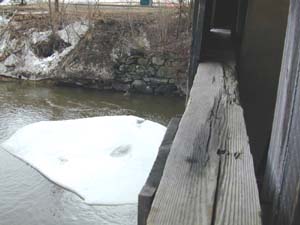
Photo by Joe Nelson
April 13, 2001
A great deal of effort was spent in lifting the bridge three feet higher over the abutments to avoid the possibility of destruction by ice and flotsam carried by spring's high water. That scenario hasn't as yet occurred. The people on the bridge saw the ice melt and peacefully drift away. By Wednesday, April 11, the river was flowing quickly with just a scattering of floating ice. One of the larger chunks is shown here. Note the level of the river at the stones in the abutments, then view the next photo.
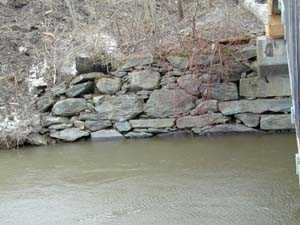
Photo by Joe Nelson
April 13, 2001
This photo was taken April 13 showing the river level to be approximately a half-foot higher than in the photo above. According to the USGS Measuring Station in the Lamoille River at Johnson, about 8 miles upstream, the water conditions have been:
- Apr. 12: flow = 2060 ft³/sec., stage = 6.08 ft.
- Apr. 13: flow = 2930 ft³/sec., stage = 7.51 ft.
- Apr. 14: flow = 2980 ft³/sec., stage = 7.59 ft.
- Apr. 15: flow = 2770 ft³/sec., stage = 7.25 ft.
Flood stage at Johnson is: flow = 7220 ft³/sec., stage = 12.5 ft.
With a near-record snowfall this year we seem to be having a miraculously gentle melt-off to go with it so far.
Cambridge, Vt. Cambridge, Vt. Friday, April 20 - The pedestrian ramps are finished and the openings in the bridge siding are closed temporarily against the weather with plywood and plastic sheeting. This and with the bridge standing three feet higher over the abutments, the first phase of the two phase project is complete.
The ramps will serve the public until the structure restoration part of the project begins this coming fall. When the work on the bridge is completed, the roadway will be restored and light motor traffic will permitted.
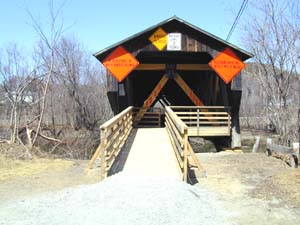
Photo by Joe Nelson
April 20, 2001
The Portals of the Poland Bridge are now served with railed pedestrian ramps. The signs read: NO RECREATIONAL OR MOTOR VEHICLES ALLOWED and PEDESTRIAN TRAFFIC ONLY BICYCLES MUST BE WALKED
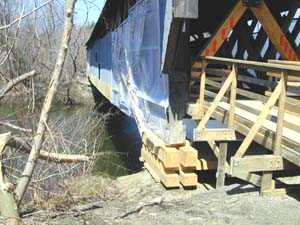
Photo by Joe Nelson
April 20, 2001
The old bridge is not very sightly right now, but the patches will soon be replaced with new siding.
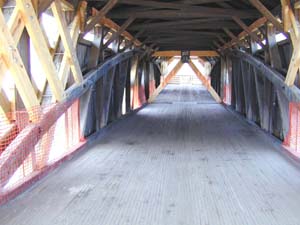
Photo by Joe Nelson
April 20, 2001
With the floor freshly swept and the interior suffused with light admitted through the plastic sheeting, the bridge feels strangely snug.
The Poland Covered Bridge Phase 2 Planning: April 2001
The Poland Covered Bridge Phase 2 Work to Begin
Cambridge Junction, April 5, 2001 - With the first phase of the project to preserve the failing Poland Covered Bridge very nearly complete, VTrans Structures Project Manager David Hoyne called an on-site meeting to exchange ideas about plans for the second phase.
The project's first phase was designed to strengthen the over-stressed bridge and to raise it three feet higher over the abutments to avoid losing the bridge to the expected spring high water.
The work on the bridge will be done in two stages under separate contracts, said Hoyne. The first stage will stabilize and raise the bridge to protect it from high water, ice and flotsam. The second stage will restore the bridge to carry light traffic.
The funds for the work on the bridge came from the $10 million National Historic Bridge Program announced by Senator James Jeffords last August. The $1 million provided for the Cambridge Junction Bridge was received by the Vermont Agency of Transportation in August to be immediately available to allow steps to be taken to ensure that the bridge survived the winter. An estimated $200,000 was earmarked for the first phase of the project; to stabilize the structure against heavy snow load or additional ice damage.
The first phase was to be complete by March 30. The plans and specifications for the second stage must be complete by September 1. Then the project will be advertised and bid packages sent out to the contractors for a completion date of the following fall. The second phase plans must be completed by September to keep the funding.
The second phase of the project is to be designed to restore the bridge and open it for light traffic.
"As you know," said Hoyne, "We have received some money to repair the structure, and the agency also has put together a covered bridge committee, and many of the members are here today. The covered bridge committee is in the process of developing a plan for how to deal with various covered bridges, the various uses, the various treatment options. This is really one of the first few cases where we want to look at the structure and evaluate the repair strategy with this preservation plan we're trying to put in place.
"I want to open the meeting up to everybody to see how we are going to go about meeting the goals and objectives of this project. You can see by looking at the structure that it's racked laterally, the truss also has a lateral sweep to it. The bottom chord also has a vertical sag.
"What we are trying to balance here is preserving what we have and at the same time producing a product that really meets the needs. In other words, can we put the shape back in the bridge, can we line things back up, get the camber back, so that we have a project that will meet the needs of the town.
"The town has decided that they would like light-vehicle load. We are assuming that to be a three ton vehicle . . . the big issue is how do we move forward with the next [phase] of the project, putting the shape back into [the bridge] and just what the extent of the repairs [will be]."
Hoynes opened the meeting to a free ranging discussion, the opinions and concerns of the attendees were expressed. These will appear here in the near future when the audio tape made of the discussions is fully transcribed.
The participants were: Ray Hayes, VTrans Resident Engineer; Matt Holden of Daniels Construction; Neil Daniels; Scott Newman, VTrans; Joe Nelson, VCBS; Ron Bechard, VCBS; John Weaver, Materials Engineer, VTrans, Eric Gilbertson, Historic Division for Preservation, Warren Tripp, Transportation; Mark Canavant, Federal Highways, Design and structures engineer; Susan Scribner, VTrans; Bob McCullough, VTrans.
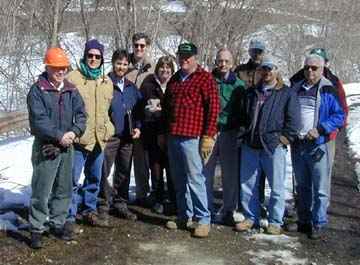
Phase 2 Meeting
Photo by Joe Nelson
April 5, 2001
From left to right: John Weaver, Mark Canavant, David Hoyne, Bob McCullough, Susan Scribner, Ray Hayes, Warren Trip, Neil Daniels, Matt Holden, Ron Bechard, and Eric Gilbertson.
